Editor’s Note: Yesterday was election day in Oregon and Washington. No matter what the outcomes were in this year’s races, plurality voting continues to constrain voters’ choices and yield unrepresentative results. Cascadian voters have the chance to reform their voting systems and ensure elections yield more representative and fair results every time.
The mainstream voting method in democracies around the world is multi-winner races and proportional voting for legislative bodies.
The most common method of vote counting in the United States—single-winner districts with plurality voting—systematically disadvantages representatives from minority communities, including people of color, third parties, and other minority groups; it fosters the spoiler effect; and rewards smear campaigns. But it is not the only option. In fact, globally, the US system is the exception to the rule. The mainstream voting method in democracies around the world is multi-winner races and proportional voting for legislative bodies. Unfortunately, most places in the United States hold on to archaic, 19th century plurality voting, and continue to get the same unrepresentative results this system has given them for nearly three centuries.
The good news is that over 300 jurisdictions in 30 states across the United States have broken out of this tradition trap. Today, Sightline is publishing a map tracking jurisdictions across the United States that use or have used one of three proportional or semi-proportional vote counting systems—cumulative, limited, or multi-winner ranked-choice—or single-winner ranked-choice voting. (Together, as shorthand, I refer to all of these voting systems as “fair voting.”) These jurisdictions include cities, counties, school districts, and states. These systems have a long history of use in nearly every corner of the country, from Portland, Maine, to Santa Monica, California, and from Spokane, Washington, to Lake Park, Florida.
This article is the first in a series of seven examining the history and impact of better, fairer voting systems in the United States, including in-depth examinations of how US voters react to these systems, use these ballots, and how these voting methods change the face of American politicians.
[button link='{“url”:”https://www.google.com/maps/d/u/0/viewer?ll=36.46787092745699%2C-101.69807465180088&z=4&mid=1U0fW2QeDl8PW_CBmOXVKp7bTyeU9cXUM”,”title”:”Click here to expand the map”}’ color=”green”]
Each of these four voting systems offers major benefits over plurality, or first-past-the-post elections, in which the candidate with the most votes wins, regardless of whether she has a majority of voters’ support. The three multi-winner systems—cumulative, limited voting, and multi-winner ranked-choice (also known as single-transferable vote (STV))—yield results that proportionally represent voters’ preferences. They make it easier for women, people of color, and third parties to win representation in legislative bodies. The single-winner systems on the map are all versions of ranked-choice voting, including instant runoff voting (IRV) and the Bucklin system. Though these systems don’t lead to proportional results (because they only elect one winner), they do prevent the spoiler effect, meaning that more voters are at least satisfied with the final winner, and eliminate the need for two-round election processes, giving jurisdictions the option to do away with primaries or runoffs. (Sightline has written thorough descriptions of these voting systems and evaluated their strengths and weaknesses elsewhere, particularly here and here.)
Though I’ve worked to make this map comprehensive, I’m no doubt missing some jurisdictions that have used one or more of the systems I track on this map. If you know of a city, county, school board, or even state with a history of using one of these systems, please let me know in the comment section below. I’ll add it to the map.
In this article I’ll explore the voting system trends the map reveals and look at some of the histories that led jurisdictions to adopt these systems. In the appendix, I’ll explain how to navigate the map.
Fair voting is everywhere in the United States
The map shows 321 places in the United States that have used cumulative, limited, or ranked-choice voting (not including states that use IRV for overseas voters). Each map marker indicates one of these places and represents both the type and status of the jurisdiction’s voting system. We’ve broken the markers into two categories.
- Green- and blue-shaded markers are for multi-winner election systems. These include single transferable vote (a proportional vote counting method) and cumulative and limited voting (both semi-proportional methods; these often yield proportional results, but might fail to do so if too many similar candidates run).
- Red- and orange-shaded markers represent single-winner voting methods. Of these, the most common today is instant runoff voting, but the map also shows 43 instances of historical use of Bucklin voting.
(See Appendix I at the end of this article for two data tables that detail where and when voters have used fair voting systems in the United States. For more information on how to navigate the map, read Appendix II at the end of this article.)
The map reveals clear trends in voting system use across the United States. Over 200 places in the United States currently use one of these voting method for local elections. Almost all of these use semi-proportional voting methods. The jurisdictions are diverse, ranging from school boards, to cities, and counties. They range in population from 120,000 in Hartford, Connecticut, to just about 1,000 in Earth, Texas. Another nearly-dozen places, all cities, use instant runoff voting (IRV) to determine single-winner races, including mayoral elections and those for posted city council seats.
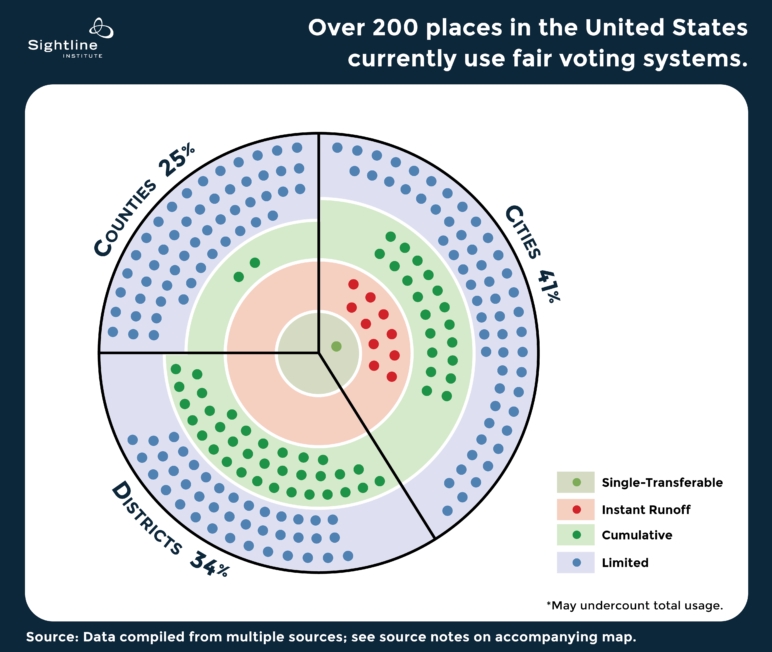
Limited voting is the system that has gotten the most play in the United States, with 147 jurisdictions currently using it (plus another 8 that historically used it) to elect local legislative bodies. Nearly two-thirds of these jurisdictions are in Pennsylvania and Connecticut. Both states prescribed limited voting in their state constitutions as a method of ensuring diversity on local elected bodies.
Least common of the voting systems is single-transferable vote (STV), the proportional, multi-winner form of ranked-choice voting. Only one place—Cambridge, Massachusetts—currently uses the system, though another 24 jurisdictions used it in the past. STV appears to be almost exclusively used in cities, as all but one of the jurisdictions with experience with this voting method are cities. The New York City school boards experimented with STV briefly but repealed its use in 2002 when the city abolished its school board system.
Three waves of adoption
States, cities, counties, and school boards in the United States adopted fair voting systems in roughly three waves from the 1870s to the present.
Overall, jurisdictions have adopted these systems for one of two reasons. In many cases, states, counties, cities, and school boards have adopted proportional or semi-proportional voting with the express purpose of increasing and maintaining diversity in elected bodies. These places include Pennsylvania, Connecticut, and cities, counties, and towns responding to minority vote dilution cases including in Alabama, New York, South Dakota, and Texas. Other jurisdictions have adopted one of these systems out of deep dissatisfaction with past election results; in many cases, these adoptions have been forms of local response, or even protest, to a national- or state-level problem. These places include Pennsylvania, where residents’ unease after the Civil War was one motivating factor for the state constitutional amendment, and the cities that have adopted IRV since the 2000 presidential election.
First wave: State constitutional adoptions to ensure fair representation for minority groups
The states of Pennsylvania and Connecticut amended their constitutions in 1871 and 1949, respectively, to prescribe limited voting as the default election method for certain local bodies. Both states did so with the express purpose of ensuring diversity, particularly of party affiliation, in elected officials. Together the two states host over 120 jurisdictions that currently use limited voting.
Pennsylvania
At least 45 of the state’s total 67 counties use limited voting today. Pennsylvania amended its state constitution in 1871 to make limited voting the default election method for at-large county councilors across the state. Charles Buckalew, who served in both the Pennsylvania state senate, and the US House and Senate, was the main local champion of the amendment. He saw proportional representation voting as a means of ensuring diverse representation in elected bodies, as well as reducing election costs and guarding against gerrymandering. (Buckalew trumpeted the benefits of proportional voting outside Pennsylvania as well; he was met with little success for his efforts in US Congress, but was instrumental in Illinois’ 1870 adoption of cumulative voting for the state legislature.) In addition to Buckalew’s advocacy in his home state, two other factors helped usher in the Pennsylvania amendment. First, England’s adoption of a similar voting system the previous year served as a recent example of the system’s legitimacy. Secondly, the US Civil War was fresh on the minds of Americans and many saw a disbalanced Congress as a key spark that ignited the war; Pennsylvania’s move to limited voting was a local response to this perceived problem on the national stage.
Connecticut
Almost 80 jurisdictions in Connecticut use limited voting for their elections today. In 1949 the state legislature prescribed limited voting for municipal boards of selectmen, boards of assessment appeals, and boards of education in order to ensure minority representation on these boards. In 1959 the legislature further stipulated that no single party could hold all seats on any elected legislative body or board. In 1972 a state resident challenged the state’s minority representation requirements. The courts upheld the requirements, writing,
The legislature felt that it was important, on boards with traditionally nonpartisan duties (if there are such in Connecticut) as well as those with clearly “political” duties, to have a significant minority voice, to air and introduce ideas which the majority might not otherwise consider. The statute was not meant to wrest power and control from the majority, but to assure intelligent decision-making…. It avoids instability by having members of two parties always present.
Thus, Connecticut’s use of limited voting is clearly for the purpose of ensuring diversity of thought in elected officials.
Second wave: A remedy for racial or ethnic minority vote dilution
Many jurisdictions in the United States adopted either cumulative or limited voting in the 1980s and 1990s as a remedy for minority vote dilution under section 2 of the Voting Rights Act (VRA). In most cases litigation spurred the adoption. In these cases claimants showed that unmodified at-large voting systems diluted voting strength of people of color. People in the racial or ethnic minority made up a significant portion of the population but still had never, or almost never, elected a single representative, because majoritarian at-large elections allow voters in the majority to elect 100 percent of the representative.
Cumulative voting
Nearly 60 local jurisdictions in five states across the United States use cumulative voting to elect city or county councilors or school board members; the majority of these are in Texas. In the early 1990s Texas courts prescribed cumulative voting as a remedy in a number of VRA cases brought on behalf of Latino communities by the League of United Latin American Citizens (LULAC). In 1995, Texas lawmakers added a section to the state’s education code permitting independent school districts to adopt cumulative voting for board member elections, making it easy for districts to proactively adopt the system.
Though Texas holds the bulk of the United States’ cumulative voting jurisdictions, there are a smattering of other places across the country, including in Alabama, New York, and South Dakota, that also use cumulative voting to prevent minority vote dilution.
Three jurisdictions in South Dakota have experience with cumulative voting; these are the only cases in which courts prescribed this system as a remedy for vote dilution violations against Native Americans. The city of Martin, South Dakota, used cumulative voting from 2006 to 2010. Though nearly 45 percent of the city’s population is Native American, the city had only elected two Native American, or Native American-preferred candidates, for over 20 years, and in both cases those candidates ran unopposed. In the city’s first cumulative voting election three Native American-preferred candidates won seats on the city council. The Wagner School District began using the system in 1990. Though 42 percent of the district’s population was Native American, only 3 Native Americans were elected to the School Board between 1983 and 2003. In the first cumulative voting election of 2003, John Sully, a Native American, won a seat on the Board. Also in that year, Sisseton Independent School District (ISD) adopted cumulative voting for its school board elections. Though the school district was over 30 percent Native American, Native Americans had rarely won seats on the board. Between 1977 and 1989 only 2 Native American candidates had won seats out of 23 who ran. In the first cumulative voting election held in the Sisseton ISD, a Native American from the Sisseton-Wahpeton Sioux tribe won a seat.
Limited voting
Nearly 150 jurisdictions in six states across the United States use limited voting to elect city or county councilors, or school board members. Though the bulk of these are in Connecticut and Pennsylvania and the result of state constitutional language (as I discussed above), 40 have adopted this voting system since 1990 as a remedy for minority vote dilution. Twenty-five jurisdictions in Alabama, almost all cities, adopted the system in the 1980s following the landmark case Dillard v Crenshaw County which alleged violations of section 2 of the VRA against African American voters (another 5 places adopted cumulative voting following this case). Beginning in the early 1990s, some 14 counties and school districts across North Carolina also implemented limited voting in response to VRA vote dilution litigation.
Third wave: Guarding against spoilers and plurality winners
Since 2000, several cities from California to Colorado to Minnesota have adopted single-winner ranked choice voting, also called instant runoff voting (IRV). Most of these cities were trying to protect against plurality voting’s problems with vote splitting, spoilers, and plurality winners. When more than two candidates run for one position, plurality voting crowns the one with the most votes the winner, but she might not have received a majority of votes. In some cases, she might not have won at all if the third-place candidate had not run, so the third-place candidate’s presence spoiled the election for the would-be winner. Perhaps the most famous instance of election spoilage was the 2000 presidential election in which many US voters blamed Ralph Nader’s campaign for spoiling Al Gore’s win.
Voters in California and Colorado were explicit that avoiding spoiled elections in future elections was a key motivation behind their adoption of IRV for local elections. Minnesotans in Minneapolis and St. Paul adopted IRV in 2008 and 2010, respectively, in response to a string of state gubernatorial elections in which a candidates won with far less than majority support. Perhaps the most striking of these was the 1998 election of Jesse Ventura, who assumed the state’s governor’s chair with just 37 percent of the vote after a three-way vote split.
Fair voting in Cascadia
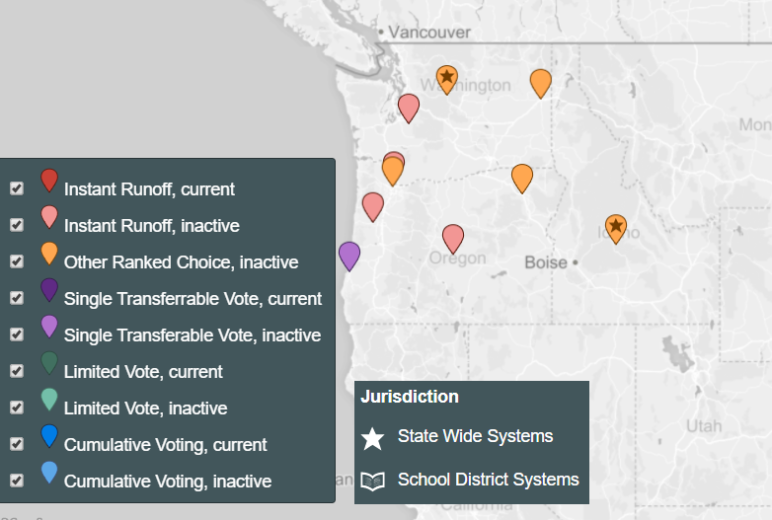
Cascadia is no stranger to better voting methods; it’s home to 10 jurisdictions that have used, or presently use, some form of ranked voting—five in Oregon, four in Washington, and one in Idaho. The majority of these used the Bucklin voting system in the early 20th century for the election of city officers or state direct primaries. Only one place in Cascadia has used a proportional representation method: Coos Bay, Oregon, used single-transferable vote briefly in the 1940s to elect city officers. More recently in the region, Pierce County, Washington, used instant runoff voting for two county election cycles. In November 2016, Benton County, Oregon, voters approved a ballot measure for the use of instant runoff voting for county sheriff and commissioners. The state has yet to approve the necessary funds for equipment upgrades, delaying implementation of the system.
As the map shows, fair voting systems have long been part of the fabric of democracy in the United States, and more than 200 places across the country currently use these systems to make their elections more equitable and representative. Click around the map and explore the history of these systems in the United States.
And stay tuned for the next article in this series: how do US voters like these voting systems?
[list_signup_button button_text=”Like what you|apos;re reading? Get our latest democracy research right to your inbox.” form_title=”Reclaiming Our Democracy” selected_lists='{“Reclaiming Our Democracy”:”Reclaiming Our Democracy”}’ align=”center”]
Thank you to CoreGIS for cartographic help with the map.
Appendix I: Fair voting systems by the numbers
The following tables present the 321 uses of fair voting systems in the United States that we’ve been able to track down as of November, 2017. The first table breaks down usage of these voting systems by their time period; over 200 places currently use one of these voting systems and another 99 have used them in the past but have since repealed them. The second table breaks down these same instances of fair voting use by the government level at which voters implemented them, ranging from school districts to statewide implementation.
We’ve likely missed many instances of fair voting system use across the United States, especially historically. Though we won’t update these tables, we will keep the accompanying map up to date as we learn of more places that have chosen to use one of these voting methods.
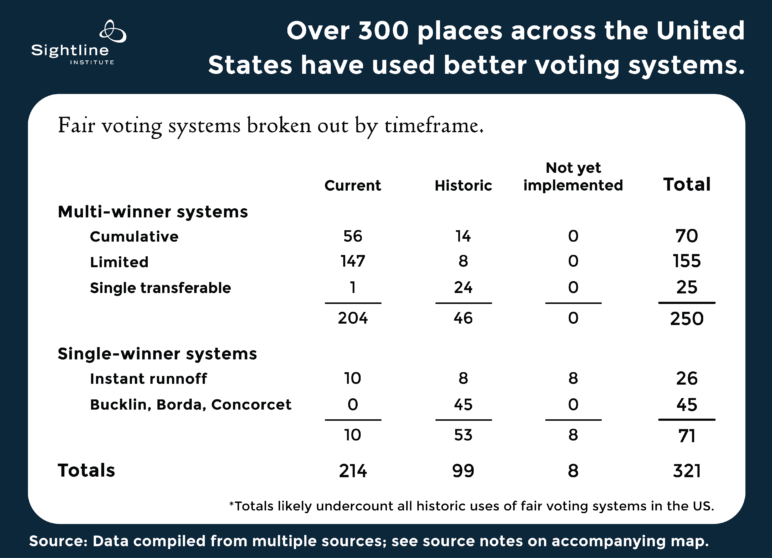
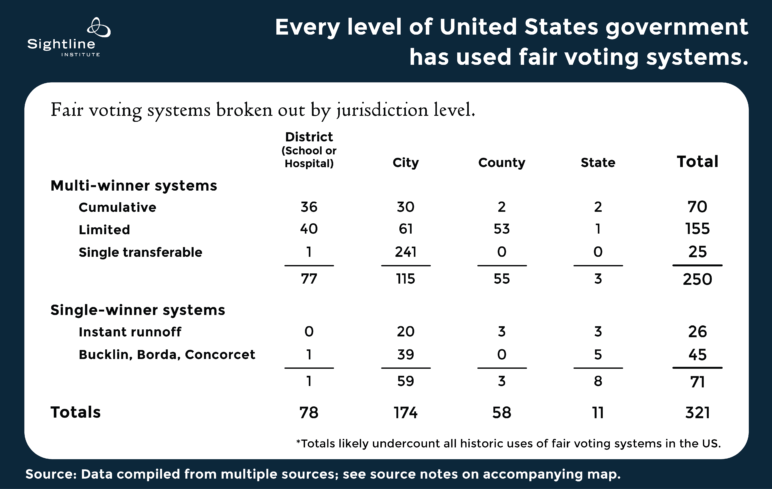
Appendix II: Navigating the map
The 321 markers on the map indicate jurisdictions that have a history of voting with methods other than majoritarian election systems (not including those that use IRV for overseas voters). We’ve broken the markers into two categories. Markers in cool colors (green and blue) represent multi-winner election systems. These include single transferable vote (a proportional vote counting method) and cumulative and limited voting (both semi-proportional methods). Markers in warm colors (red and orange) represent single-winner voting methods. Of these, the most common today is instant runoff voting, but the map also shows 43 instances of historical use of Bucklin voting.
Darker hues (for example, red) mean the system is currently in use while lighter hues (for example, pink) indicate inactive systems. Inactive systems are those that a jurisdiction either historically used and has discontinued, or those that a jurisdiction has passed legislation to use but has yet to implement the legislation by running an election with that system. For example, in the image below the dark red marker indicates Basalt, Colorado, currently uses IRV, while the light red marker shows that Aspen no longer uses this system.
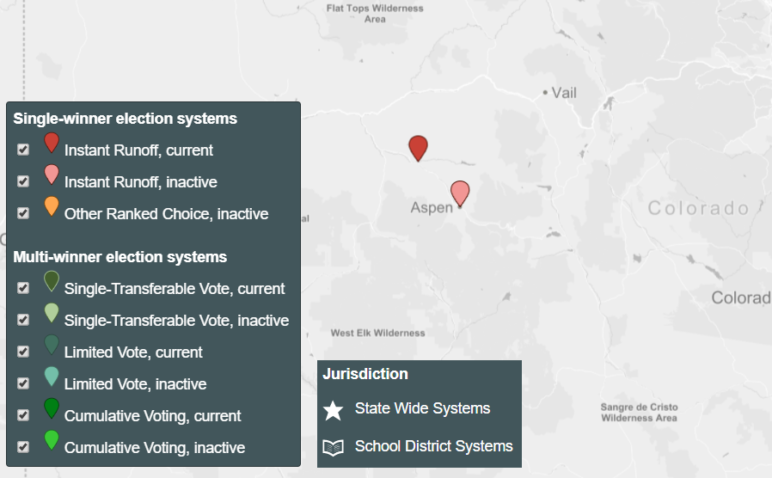
Some of the markers have small icons, which indicate the jurisdiction type. Stars represent state-level elections; an open book indicates school board member elections. The only state currently working to implement a better voting system is Maine. (There, voters approved the use of IRV for statewide and federal elections in 2016, but the state has yet to implement the system in an election. In October 2017, the Maine legislature voted to postpone implementation of the system until 2021, with the option of repealing it then. A few days later voting reform advocates in the state began collecting signatures to counter the legislature’s decision.)
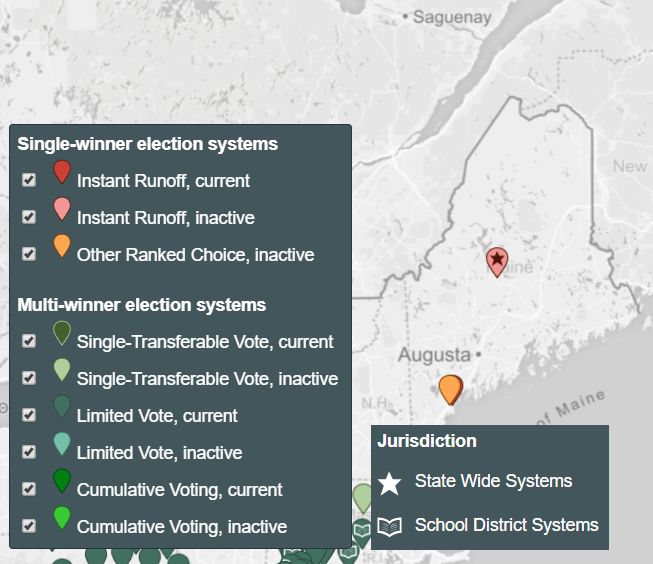
Clicking on each marker brings up a popup box with more information, including the specific type of election method, the years it was used, and the offices it was used to elect. The pop up boxes also contain hyperlinks to more information about the use of the voting system; sometimes these are links to local news articles, exit polls, or the text of enabling legislation.
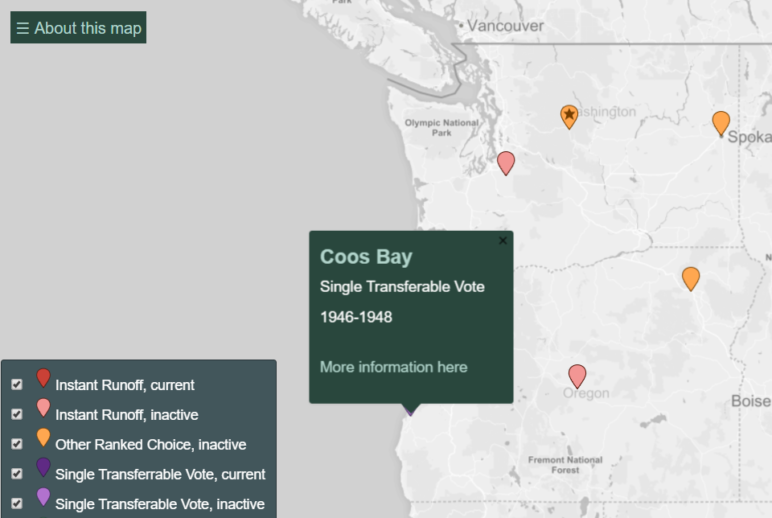
Some pop up boxes contain photos and tell the stories of people who won office because of the voting system.
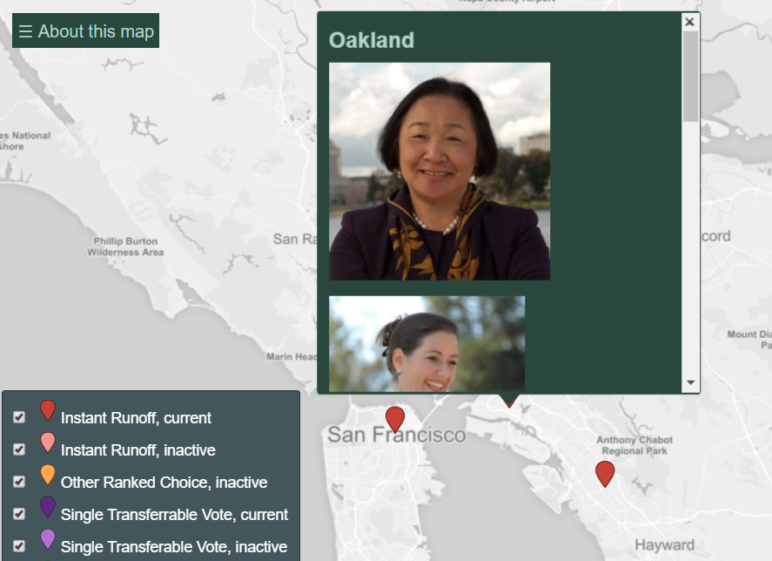


Comments are closed.